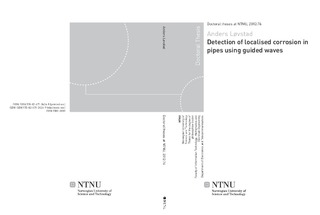| dc.contributor.author | Løvstad, Anders | nb_NO |
| dc.date.accessioned | 2014-12-19T13:47:19Z | |
| dc.date.accessioned | 2015-12-22T11:46:23Z | |
| dc.date.available | 2014-12-19T13:47:19Z | |
| dc.date.available | 2015-12-22T11:46:23Z | |
| dc.date.created | 2012-07-05 | nb_NO |
| dc.date.issued | 2012 | nb_NO |
| dc.identifier | 539867 | nb_NO |
| dc.identifier.isbn | 978-82-471-3424-5 (printed ver.) | nb_NO |
| dc.identifier.isbn | 978-82-471-3426-9 (electronic ver.) | |
| dc.identifier.uri | http://hdl.handle.net/11250/2370446 | |
| dc.description.abstract | The work in this thesis is motivated by a need to improve non- destructive testing (NDT) techniques as petrochemical production moves towards harsher environments, with increasing presence of CO2 and/or H2S in the production lines, which in turn lead to an increasing risk of shutdown due to localised corrosion. From a practical NDT point of view, the maximum corrosion depth within the area inspected is the most important parameter to quantify accurately. However, localised corrosion exhibits a large scatter in shape and growth rate, making it insidious and difficult to detect and size in practice.
Initially, relatively simple shaped defects such as infinite notches and single through-thickness holes in plates are considered, comparing the reflection and scattering from them with available results from the literature for validation, before attention is given to more complex defects in pipes, with the fundamental torsional guided wave, T(0,1), incident.
Firstly, a parametric study of the reflection from two and three small circular holes is presented. FE analyses estimating the reflection coefficients (RC) for both part- and through thickness holes at different relative positions are presented, and the validity limits of employing the superposition technique in doing so assessed. Results show that the RC for the T(0,1) mode is dependent on absolute frequency and axial separation, and independent of circumferential position of the holes. Employing superposition is found to be valid down to defect centre to centre separation distances of two diameters in the worst case, with improved validity with shallower defects.
Then the reflection of the T(0,1) mode from a large number of pit clusters consisting of a random number of pits that have developed randomly in size and depth following certain growth rules is investigated, assessing the relationship between maximum pit depth and maximum RC. Problematic cases where low maximum RCs are obtained from pit clusters with deep maximum pit depth are investigated in detail. Results show that the majority of such clusters consist of a single small and deep pit, with otherwise shallow attack only; such corrosion morphologies are unlikely to occur in practice. With more realistic pit cluster morphologies, where the pit clusters are part of a larger, wider corrosion attack, fewer cases with deep maximum pit depth result in a low maximum RC.
A 2D FFT approach is used to further assess the problematic features identified by studying the relationship between the spatial frequencies of corrosion patches and their RC spectra. Results indicate that sharp changes in depth result in significant reflections at high frequencies, and only to a minor extent affect RCs at lower frequencies. A subsequent analysis of whether pit clusters with sharp sided pits can be represented as a single, complex defect showed that it is not a valid approximation; as a consequence of the poor agreement found, the maximum depth of the problematic corrosion profiles cannot be well estimated without consideration of the high spatial frequency content of the corrosion profiles.
| nb_NO |
| dc.language | eng | nb_NO |
| dc.publisher | Norges teknisk-naturvitenskapelige universitet, Fakultet for informasjonsteknologi, matematikk og elektroteknikk, Institutt for elektronikk og telekommunikasjon | nb_NO |
| dc.relation.ispartofseries | Doktoravhandlinger ved NTNU, 1503-8181; 2012:76 | nb_NO |
| dc.title | Detection of localised corrosion in pipes using guided waves | nb_NO |
| dc.type | Doctoral thesis | nb_NO |
| dc.contributor.department | Norges teknisk-naturvitenskapelige universitet, Fakultet for informasjonsteknologi, matematikk og elektroteknikk, Institutt for elektronikk og telekommunikasjon | nb_NO |
| dc.description.degree | PhD i elektronikk og telekommunikasjon | nb_NO |
| dc.description.degree | PhD in Electronics and Telecommunication | |
